外研版九年级上册Module 12 Save our world拔尖检测卷(含答案)
文档属性
| 名称 | 外研版九年级上册Module 12 Save our world拔尖检测卷(含答案) | 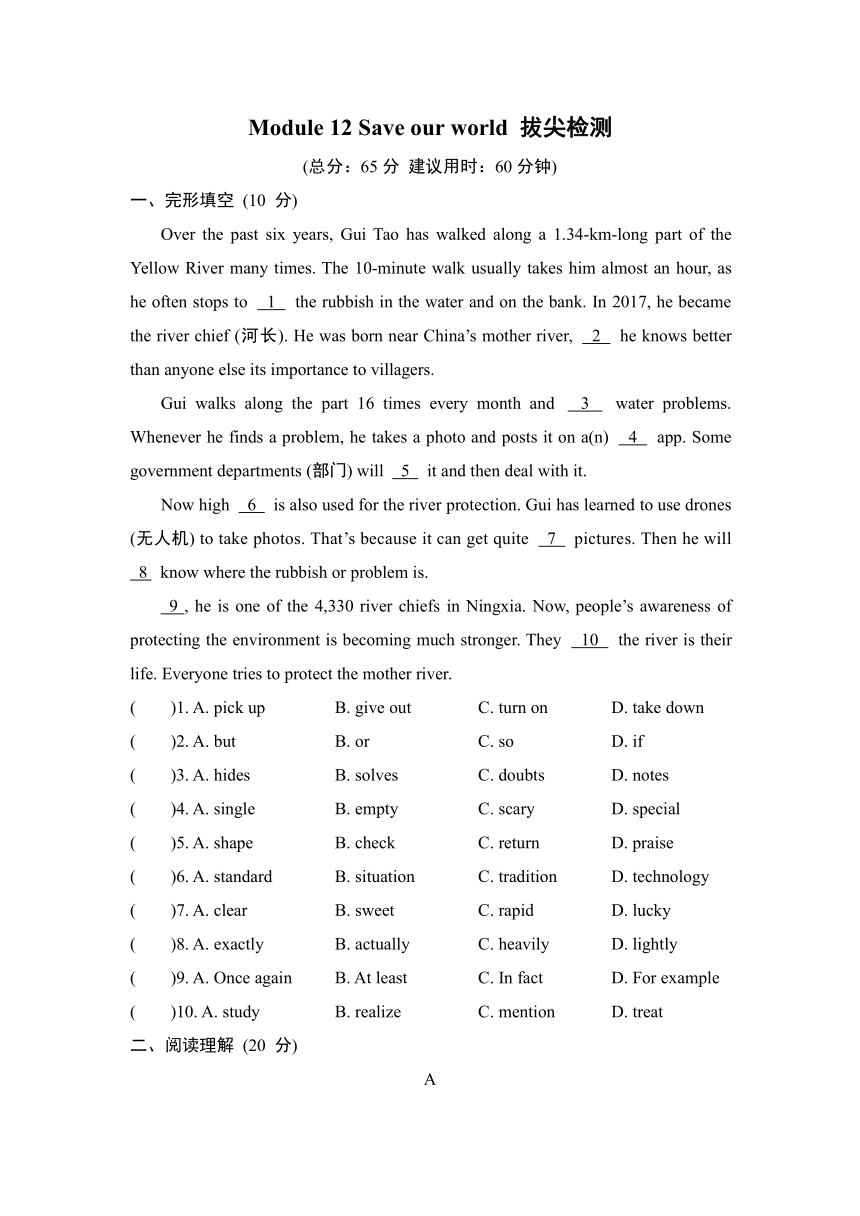 | |
| 格式 | doc | ||
| 文件大小 | 521.0KB | ||
| 资源类型 | 教案 | ||
| 版本资源 | 外研版 | ||
| 科目 | 英语 | ||
| 更新时间 | 2025-04-02 15:46:08 | ||
图片预览

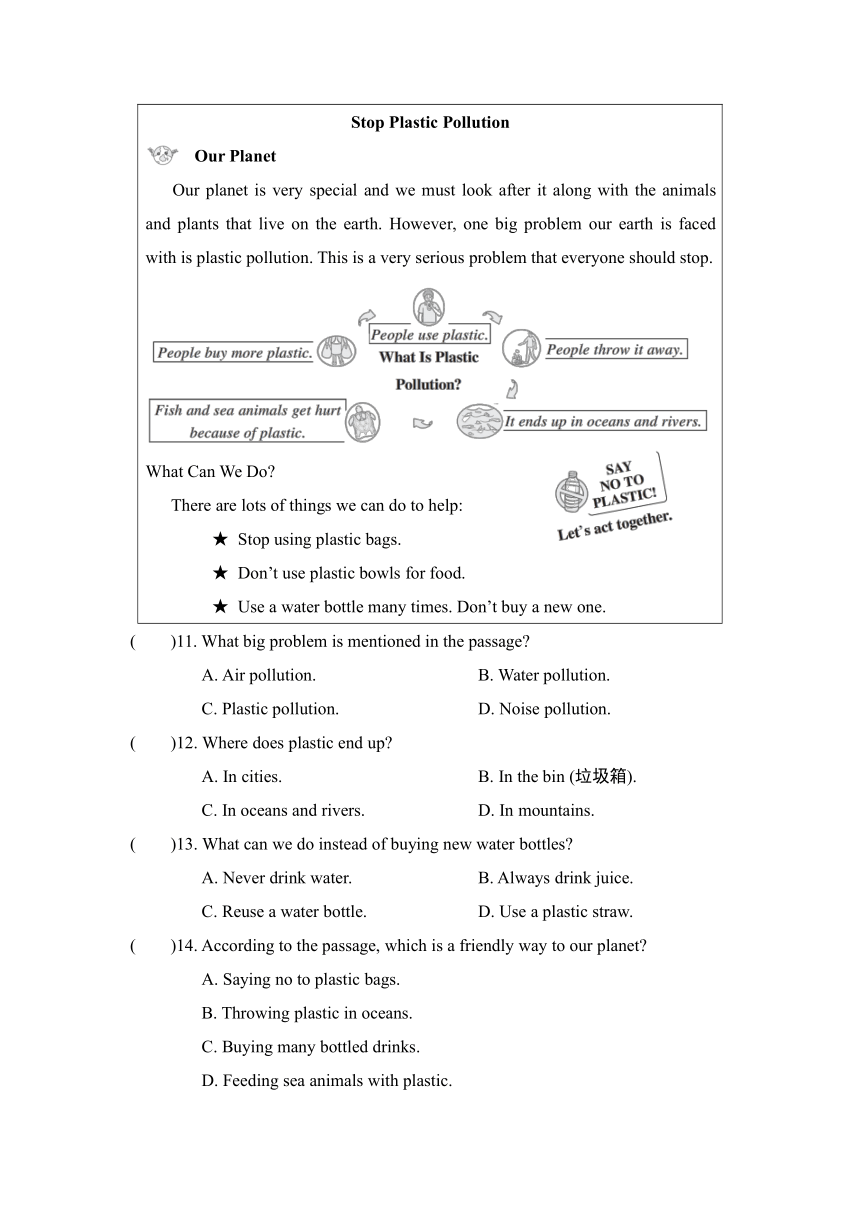
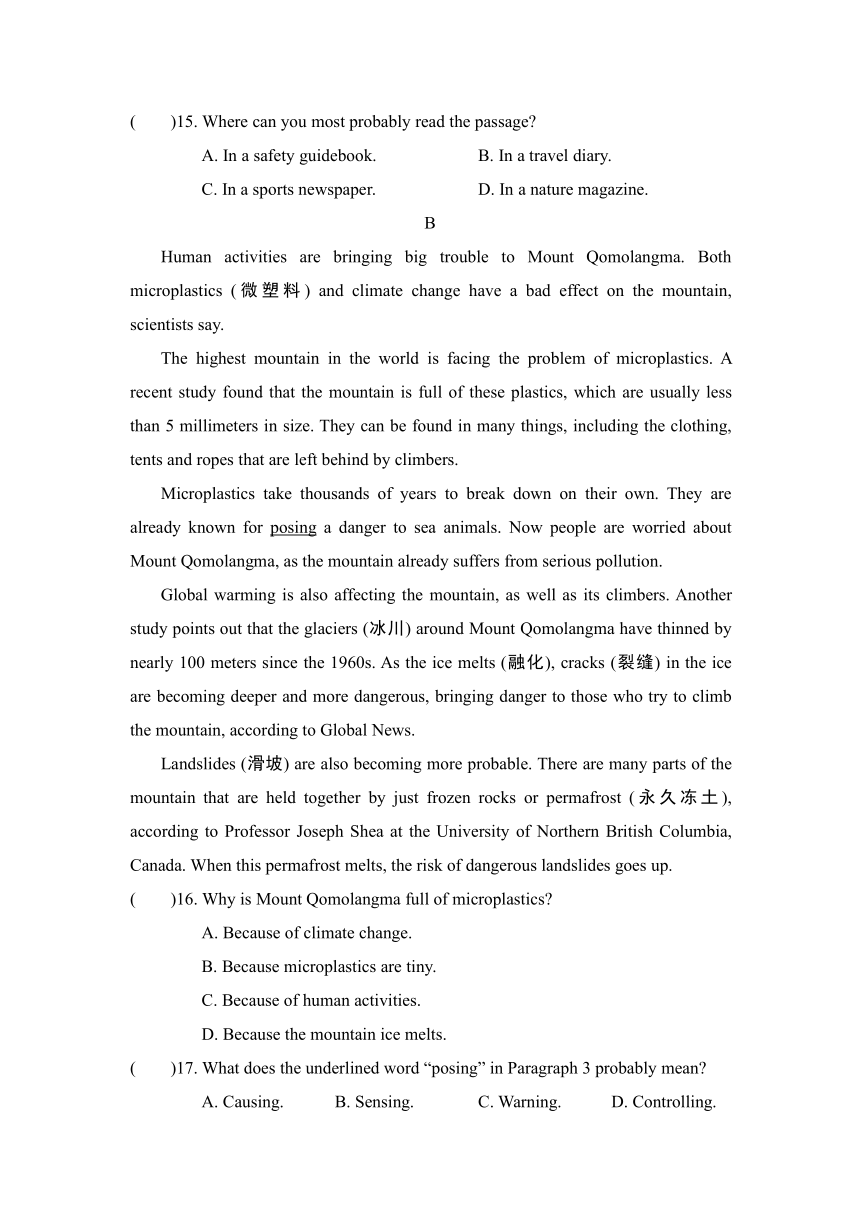
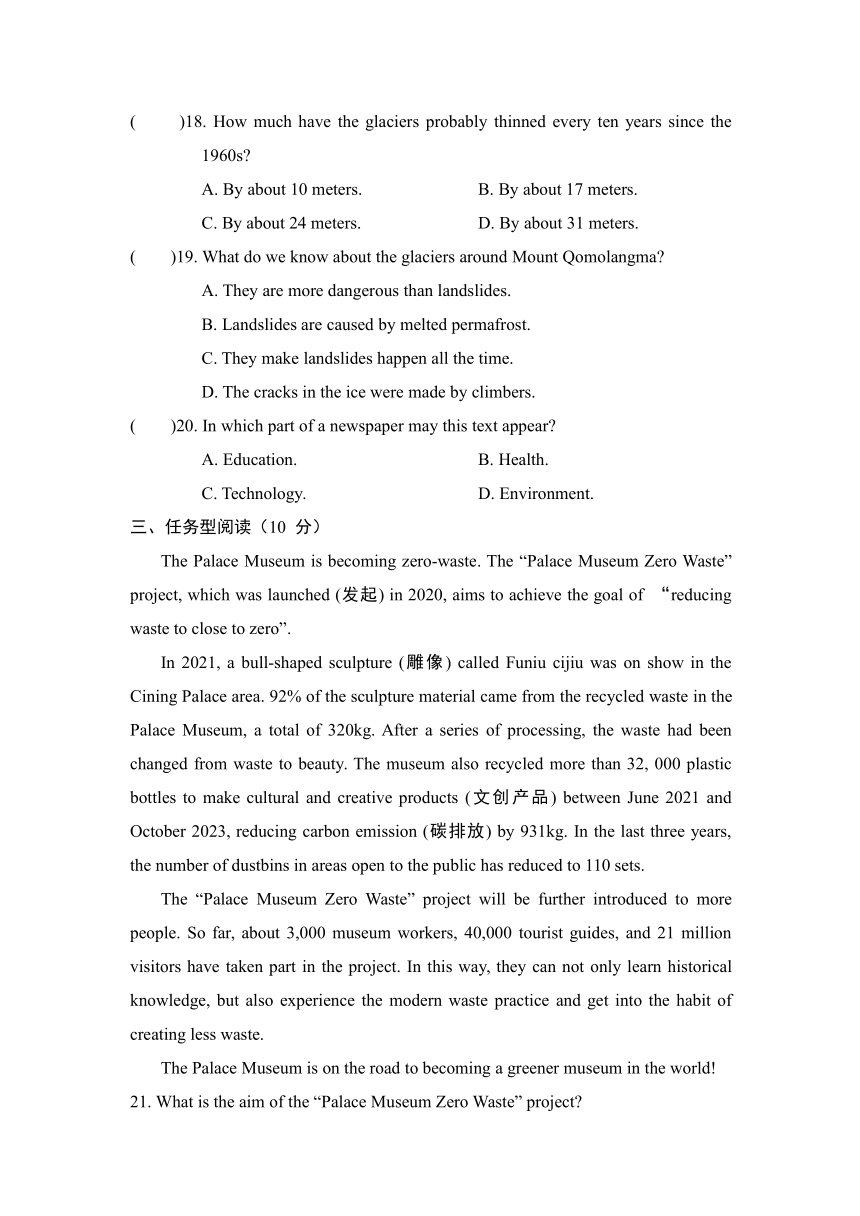
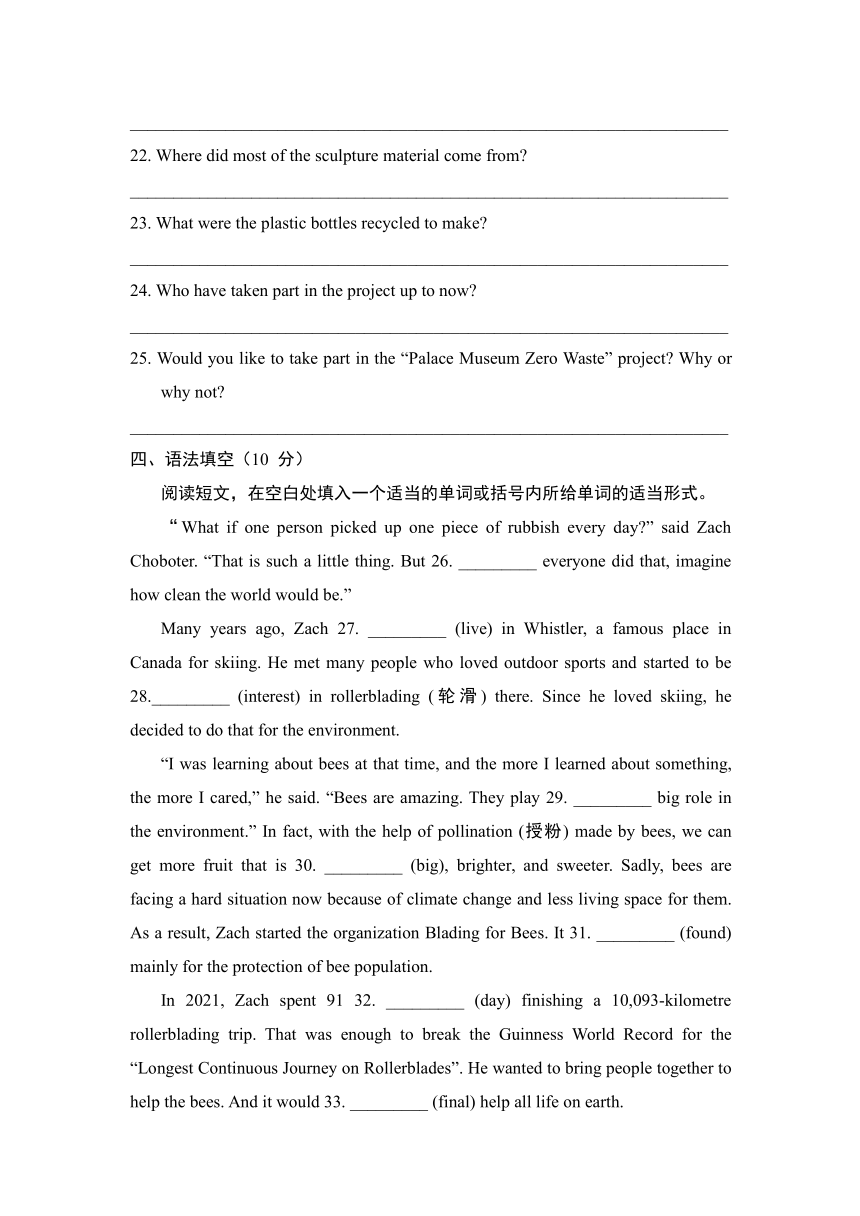
文档简介
Module 12 Save our world 拔尖检测
(总分:65分 建议用时:60分钟)
一、完形填空 (10 分)
Over the past six years, Gui Tao has walked along a 1.34-km-long part of the Yellow River many times. The 10-minute walk usually takes him almost an hour, as he often stops to 1 the rubbish in the water and on the bank. In 2017, he became the river chief (河长). He was born near China’s mother river, 2 he knows better than anyone else its importance to villagers.
Gui walks along the part 16 times every month and 3 water problems. Whenever he finds a problem, he takes a photo and posts it on a(n) 4 app. Some government departments (部门) will 5 it and then deal with it.
Now high 6 is also used for the river protection. Gui has learned to use drones (无人机) to take photos. That’s because it can get quite 7 pictures. Then he will
8 . know where the rubbish or problem is.
9 , he is one of the 4,330 river chiefs in Ningxia. Now, people’s awareness of protecting the environment is becoming much stronger. They 10 the river is their life. Everyone tries to protect the mother river.
( )1. A. pick up B. give out C. turn on D. take down
( )2. A. but B. or C. so D. if
( )3. A. hides B. solves C. doubts D. notes
( )4. A. single B. empty C. scary D. special
( )5. A. shape B. check C. return D. praise
( )6. A. standard B. situation C. tradition D. technology
( )7. A. clear B. sweet C. rapid D. lucky
( )8. A. exactly B. actually C. heavily D. lightly
( )9. A. Once again B. At least C. In fact D. For example
( )10. A. study B. realize C. mention D. treat
二、阅读理解 (20 分)
A
Stop Plastic PollutionOur PlanetOur planet is very special and we must look after it along with the animals and plants that live on the earth. However, one big problem our earth is faced with is plastic pollution. This is a very serious problem that everyone should stop.What Can We Do There are lots of things we can do to help:★ Stop using plastic bags.★ Don’t use plastic bowls for food.★ Use a water bottle many times. Don’t buy a new one.
( )11. What big problem is mentioned in the passage
A. Air pollution. B. Water pollution.
C. Plastic pollution. D. Noise pollution.
( )12. Where does plastic end up
A. In cities. B. In the bin (垃圾箱).
C. In oceans and rivers. D. In mountains.
( )13. What can we do instead of buying new water bottles
A. Never drink water. B. Always drink juice.
C. Reuse a water bottle. D. Use a plastic straw.
( )14. According to the passage, which is a friendly way to our planet
A. Saying no to plastic bags.
B. Throwing plastic in oceans.
C. Buying many bottled drinks.
D. Feeding sea animals with plastic.
( )15. Where can you most probably read the passage
A. In a safety guidebook. B. In a travel diary.
C. In a sports newspaper. D. In a nature magazine.
B
Human activities are bringing big trouble to Mount Qomolangma. Both microplastics (微塑料) and climate change have a bad effect on the mountain, scientists say.
The highest mountain in the world is facing the problem of microplastics. A recent study found that the mountain is full of these plastics, which are usually less than 5 millimeters in size. They can be found in many things, including the clothing, tents and ropes that are left behind by climbers.
Microplastics take thousands of years to break down on their own. They are already known for posing a danger to sea animals. Now people are worried about Mount Qomolangma, as the mountain already suffers from serious pollution.
Global warming is also affecting the mountain, as well as its climbers. Another study points out that the glaciers (冰川) around Mount Qomolangma have thinned by nearly 100 meters since the 1960s. As the ice melts (融化), cracks (裂缝) in the ice are becoming deeper and more dangerous, bringing danger to those who try to climb the mountain, according to Global News.
Landslides (滑坡) are also becoming more probable. There are many parts of the mountain that are held together by just frozen rocks or permafrost (永久冻土), according to Professor Joseph Shea at the University of Northern British Columbia, Canada. When this permafrost melts, the risk of dangerous landslides goes up.
( )16. Why is Mount Qomolangma full of microplastics
A. Because of climate change.
B. Because microplastics are tiny.
C. Because of human activities.
D. Because the mountain ice melts.
( )17. What does the underlined word “posing” in Paragraph 3 probably mean
A. Causing. B. Sensing. C. Warning. D. Controlling.
( )18. How much have the glaciers probably thinned every ten years since the 1960s
A. By about 10 meters. B. By about 17 meters.
C. By about 24 meters. D. By about 31 meters.
( )19. What do we know about the glaciers around Mount Qomolangma
A. They are more dangerous than landslides.
B. Landslides are caused by melted permafrost.
C. They make landslides happen all the time.
D. The cracks in the ice were made by climbers.
( )20. In which part of a newspaper may this text appear
A. Education. B. Health.
C. Technology. D. Environment.
三、任务型阅读(10 分)
The Palace Museum is becoming zero-waste. The “Palace Museum Zero Waste” project, which was launched (发起) in 2020, aims to achieve the goal of “reducing waste to close to zero”.
In 2021, a bull-shaped sculpture (雕像) called Funiu cijiu was on show in the Cining Palace area. 92% of the sculpture material came from the recycled waste in the Palace Museum, a total of 320kg. After a series of processing, the waste had been changed from waste to beauty. The museum also recycled more than 32, 000 plastic bottles to make cultural and creative products (文创产品) between June 2021 and October 2023, reducing carbon emission (碳排放) by 931kg. In the last three years, the number of dustbins in areas open to the public has reduced to 110 sets.
The “Palace Museum Zero Waste” project will be further introduced to more people. So far, about 3,000 museum workers, 40,000 tourist guides, and 21 million visitors have taken part in the project. In this way, they can not only learn historical knowledge, but also experience the modern waste practice and get into the habit of creating less waste.
The Palace Museum is on the road to becoming a greener museum in the world!
21. What is the aim of the “Palace Museum Zero Waste” project
_____________________________________________________________________
22. Where did most of the sculpture material come from
_____________________________________________________________________
23. What were the plastic bottles recycled to make
_____________________________________________________________________
24. Who have taken part in the project up to now
_____________________________________________________________________
25. Would you like to take part in the “Palace Museum Zero Waste” project Why or why not
_____________________________________________________________________
四、语法填空(10 分)
阅读短文,在空白处填入一个适当的单词或括号内所给单词的适当形式。
“What if one person picked up one piece of rubbish every day ” said Zach Choboter. “That is such a little thing. But 26. _________ everyone did that, imagine how clean the world would be.”
Many years ago, Zach 27. _________ (live) in Whistler, a famous place in Canada for skiing. He met many people who loved outdoor sports and started to be 28._________ (interest) in rollerblading (轮滑) there. Since he loved skiing, he decided to do that for the environment.
“I was learning about bees at that time, and the more I learned about something, the more I cared,” he said. “Bees are amazing. They play 29. _________ big role in the environment.” In fact, with the help of pollination (授粉) made by bees, we can get more fruit that is 30. _________ (big), brighter, and sweeter. Sadly, bees are facing a hard situation now because of climate change and less living space for them. As a result, Zach started the organization Blading for Bees. It 31. _________ (found) mainly for the protection of bee population.
In 2021, Zach spent 91 32. _________ (day) finishing a 10,093-kilometre rollerblading trip. That was enough to break the Guinness World Record for the “Longest Continuous Journey on Rollerblades”. He wanted to bring people together to help the bees. And it would 33. _________ (final) help all life on earth.
Zach’s trip isn’t over yet. In 2025, he plans to travel 34. _________ the world on rollerblades to let more people know about bees’ situation. And he advises people to start with little things in life, such as picking up rubbish, or planting wildflowers. Zach thinks that if everyone does so, it will make a big 35. _________ (different) to the earth.
五、书面表达(15 分)
现在,越来越多的人开始加入低碳生活的行列。假如你是李华,请根据以下提示,以“What Can We Do to Live a Low-carbon Life ”为题,写一篇80— 10 0 词的英语演讲稿。
注意:开头和结尾已为你写好,不计入总词数。
参考词汇:一次性的disposable
What Can We Do to Live a Low-carbon Life
Hello, everyone. I’m Li Hua. It’s nice to speak about what we can do to live a low-carbon life.
_______________________________________________________________________________________________________________________________________________________________________________________________________________________________________________________________________________________________________________________________________________________________________________________________________________________________________________________________________________________________________________________________________________________________________________________________________________________________________________________________________________________________________________________________________________________________________________________
Thank you for your listening.
Module 12 拔尖检测
一、【主旨大意】本文主要讲述了河长桂涛保护黄河的故事。
1. A 【点拨】pick up 捡起;give out 分发;turn on 打开;take down 记下。根据“...the rubbish in the water and on the bank.”可 知,此处是指他停下来捡起垃圾。故选A。
2. C 【点拨】根据下文“he knows better than anyone else its importance to villagers”可知,他出生在母亲河附近,所以他比其他人更懂得母亲河对村民的重要性。故选C。
3. B 【点拨】根据下文“Whenever he finds a problem, he takes a photo and posts it on a(n)... app. Some government departments will ... it and then deal with it.”可知,此处是指解决问题。故选B。
4. D 【点拨】single 单一的;empty 空的;scary 吓人的;special 特殊的。根据下文“Some government departments”可知,此处是指一个特殊的应用程序。故选D。
5. B 【点拨】shape 塑形;check 检查,核查;return 返回;praise 称赞。根据下文“and then deal with it”可知,此处是指相关工作人员先核查,后处理。故选B。
6. D 【点拨】standard 标准;situation 情况;tradition 传统; technology 技术。根据下文“use drones to take photos”可知, 此处是指使用高科技来保护河流。故选D。
7. A 【点拨】clear 清晰的;sweet 甜蜜的;rapid 快速的;lucky 幸运的。根据下文“know where the rubbish or problem is”可知, 清晰的图片有助于更方便知道垃圾或问题的所在位置。故选A。
8. A 【点拨】exactly 准确地;actually 事实上;heavily 大量地; lightly 轻轻地。根据下文“know where the rubbish or problem is”可知,此处是指准确地知道垃圾或问题的所在位置。故选A。
9. C 【点拨】Once again 再一次;At least 至少;In fact 事实上; For example 例如。根据下文“he is one of the 4, 330 river chiefs in Ningxia”可知,此处是指一个事实,桂涛只是众多河长中的一个。故选C。
10. B 【点拨】study 学习;realize 意识到;mention 提及;treat 对 待。根据下文“the river is their life”可知,河流就是他们的生命, 这是人们意识到的问题。故选B。
二、A)【主旨大意】本文主要讲述了地球正面临着塑料污染问题, 我们应该做些事情来阻止塑料污染。
11. C 【点拨】细节理解题。根据“However, one big problem our earth is faced with is plastic pollution.”可知,文中提及的大问题是塑料污染。故选C。
12. C 【点拨】细节理解题。根据图中“It ends up in oceans and rivers.”可知塑料最终到了海洋和河流中,故选C。
13. C 【点拨】细节理解题。根据“Use a water bottle many times. Don’t buy a new one.”可知,我们可以重复使用水瓶来代替购买新水瓶,故选C。
14. A 【点拨】细节理解题。根据“There are lots of things we can do to help... Stop using plastic bags.”可知,拒绝使用塑料袋是友好对待地球的方式。故选A。
15. D 【点拨】推理判断题。本文主要讲述了地球正面临着塑料污染问题,我们应该做些事情来阻止塑料污染。属于环境保护类文章,可能会在自然杂志上读到。故选D。
B )【主旨大意】本文介绍了微塑料和气候变化对珠穆朗玛峰产生了不良影响。
16. C 【点拨】细节理解题。根据第二段“They can be found in many things, including the clothing, tents and ropes that are left behind by climbers.”可知,珠穆朗玛峰上充满了微塑料,是因为人类的活动。故选C。
17. A 【点拨】词义猜测题。根据前后文含义以及结合选项可知,此处posing意为“引起”,与causing同义,故选A。
18. B 【点拨】推理判断题。根据第四段“Another study points out that the glaciers around Mount Qomolangma have thinned by nearly 100 meters since the 1960s.”可知,自20世纪60年代以来,珠穆朗玛峰周围的冰川已经变薄了近100米。20世纪60年代至今大约60年,所以冰川每十年大约变薄17米。故选B。
19. B 【点拨】细节理解题。根据文意可知,山上有许多部分是仅仅被冻结的岩石或永久冻土连接在一起的,当这些永久冻土融化时,危险的滑坡风险就会上升。由此可知滑坡是由融化的永久冻土引起的,故选B。
20. D 【点拨】推理判断题。通读全文可知,文章介绍了微塑料和气候变化对珠穆朗玛峰产生了不良影响,与环境相关。故选D。
三、【主旨大意】本文主要介绍了“故宫零废弃”项目。
21. To achieve the goal of“reducing waste to close to zero”.
22. The recycled waste in the Palace Museum.
23. Cultural and creative products.
24. Museum workers, tourist guides and visitors.
25. Yes. Because I can learn historical knowledge./Because I can experience the modern waste practice./Because I can get into the habit of creating less waste.(答案不唯一)
四、【主旨大意】本文介绍了扎克·乔博特提倡通过每天捡拾垃圾和保护蜜蜂来改善环境。他创立了“为蜜蜂滑行”组织,并打破了轮滑旅行的吉尼斯世界纪录,计划在2025年继续环球旅行,以提高人们对蜜蜂困境的认识,并鼓励人们从小事做起,共同保护地球。
26. if 【点拨】此处表示假设,if“如果”符合语境,引导条件状语从句。故填if。
27. lived 【点拨】这里描述的是过去的事情,所以应该使用一般过去时,live的过去式为lived。故填lived。
28. interested 【点拨】be interested in表示“对……感兴趣”,固定短语。故填interested。
29. a 【点拨】此处表泛指,需要一个不定冠词来修饰名词role,big以辅音音素开头,因此用a。故填a。
30. bigger 【点拨】and表并列,brighter和sweeter都是比较级,big也需用比较级bigger。故填bigger。
31. was founded 【点拨】It和动词found“建立”之间是动宾关系,需用被动语态,句子描述的是过去发生的事情,主语为It,be动词用was,found的过去分词为founded。故填was founded。
32. days 【点拨】由数字91可知,此处需用名词复数形式days,表示“91天”。故填days。
33. finally 【点拨】分析句子结构可知,此处是修饰动词help,需用副词形式finally。故填finally。
34. around 【点拨】此处表示“环游世界”,用介词around。故填around。
35. difference 【点拨】make a difference意为“有影响”,固定短语,此处表示对地球产生巨大的影响。故填difference。
五、One possible version:
What Can We Do to Live a Low-carbon Life
Hello, everyone. I’m Li Hua. It’s nice to speak about what we can do to live a low-carbon life.
First, we should plant more trees instead of cutting them down, because trees can not only stop the wind from blowing the earth away but also prevent the water from washing the earth away. Second, when we go out or travel a short distance, we had better walk or ride a bike instead of taking a car. Third, we ought to save water and electricity. For example, when we leave the room, we should turn off the lights. We should also turn off the tap in time after washing hands. Last, we ought to take a cloth bag when we go shopping. We shouldn’t use disposable chopsticks. We had better recycle waste paper and drink bottles.
In fact, even the simplest everyday activities can make a real difference to the environment. I believe we can make the earth a better place to live in.
Thank you for your listening.
(总分:65分 建议用时:60分钟)
一、完形填空 (10 分)
Over the past six years, Gui Tao has walked along a 1.34-km-long part of the Yellow River many times. The 10-minute walk usually takes him almost an hour, as he often stops to 1 the rubbish in the water and on the bank. In 2017, he became the river chief (河长). He was born near China’s mother river, 2 he knows better than anyone else its importance to villagers.
Gui walks along the part 16 times every month and 3 water problems. Whenever he finds a problem, he takes a photo and posts it on a(n) 4 app. Some government departments (部门) will 5 it and then deal with it.
Now high 6 is also used for the river protection. Gui has learned to use drones (无人机) to take photos. That’s because it can get quite 7 pictures. Then he will
8 . know where the rubbish or problem is.
9 , he is one of the 4,330 river chiefs in Ningxia. Now, people’s awareness of protecting the environment is becoming much stronger. They 10 the river is their life. Everyone tries to protect the mother river.
( )1. A. pick up B. give out C. turn on D. take down
( )2. A. but B. or C. so D. if
( )3. A. hides B. solves C. doubts D. notes
( )4. A. single B. empty C. scary D. special
( )5. A. shape B. check C. return D. praise
( )6. A. standard B. situation C. tradition D. technology
( )7. A. clear B. sweet C. rapid D. lucky
( )8. A. exactly B. actually C. heavily D. lightly
( )9. A. Once again B. At least C. In fact D. For example
( )10. A. study B. realize C. mention D. treat
二、阅读理解 (20 分)
A
Stop Plastic PollutionOur PlanetOur planet is very special and we must look after it along with the animals and plants that live on the earth. However, one big problem our earth is faced with is plastic pollution. This is a very serious problem that everyone should stop.What Can We Do There are lots of things we can do to help:★ Stop using plastic bags.★ Don’t use plastic bowls for food.★ Use a water bottle many times. Don’t buy a new one.
( )11. What big problem is mentioned in the passage
A. Air pollution. B. Water pollution.
C. Plastic pollution. D. Noise pollution.
( )12. Where does plastic end up
A. In cities. B. In the bin (垃圾箱).
C. In oceans and rivers. D. In mountains.
( )13. What can we do instead of buying new water bottles
A. Never drink water. B. Always drink juice.
C. Reuse a water bottle. D. Use a plastic straw.
( )14. According to the passage, which is a friendly way to our planet
A. Saying no to plastic bags.
B. Throwing plastic in oceans.
C. Buying many bottled drinks.
D. Feeding sea animals with plastic.
( )15. Where can you most probably read the passage
A. In a safety guidebook. B. In a travel diary.
C. In a sports newspaper. D. In a nature magazine.
B
Human activities are bringing big trouble to Mount Qomolangma. Both microplastics (微塑料) and climate change have a bad effect on the mountain, scientists say.
The highest mountain in the world is facing the problem of microplastics. A recent study found that the mountain is full of these plastics, which are usually less than 5 millimeters in size. They can be found in many things, including the clothing, tents and ropes that are left behind by climbers.
Microplastics take thousands of years to break down on their own. They are already known for posing a danger to sea animals. Now people are worried about Mount Qomolangma, as the mountain already suffers from serious pollution.
Global warming is also affecting the mountain, as well as its climbers. Another study points out that the glaciers (冰川) around Mount Qomolangma have thinned by nearly 100 meters since the 1960s. As the ice melts (融化), cracks (裂缝) in the ice are becoming deeper and more dangerous, bringing danger to those who try to climb the mountain, according to Global News.
Landslides (滑坡) are also becoming more probable. There are many parts of the mountain that are held together by just frozen rocks or permafrost (永久冻土), according to Professor Joseph Shea at the University of Northern British Columbia, Canada. When this permafrost melts, the risk of dangerous landslides goes up.
( )16. Why is Mount Qomolangma full of microplastics
A. Because of climate change.
B. Because microplastics are tiny.
C. Because of human activities.
D. Because the mountain ice melts.
( )17. What does the underlined word “posing” in Paragraph 3 probably mean
A. Causing. B. Sensing. C. Warning. D. Controlling.
( )18. How much have the glaciers probably thinned every ten years since the 1960s
A. By about 10 meters. B. By about 17 meters.
C. By about 24 meters. D. By about 31 meters.
( )19. What do we know about the glaciers around Mount Qomolangma
A. They are more dangerous than landslides.
B. Landslides are caused by melted permafrost.
C. They make landslides happen all the time.
D. The cracks in the ice were made by climbers.
( )20. In which part of a newspaper may this text appear
A. Education. B. Health.
C. Technology. D. Environment.
三、任务型阅读(10 分)
The Palace Museum is becoming zero-waste. The “Palace Museum Zero Waste” project, which was launched (发起) in 2020, aims to achieve the goal of “reducing waste to close to zero”.
In 2021, a bull-shaped sculpture (雕像) called Funiu cijiu was on show in the Cining Palace area. 92% of the sculpture material came from the recycled waste in the Palace Museum, a total of 320kg. After a series of processing, the waste had been changed from waste to beauty. The museum also recycled more than 32, 000 plastic bottles to make cultural and creative products (文创产品) between June 2021 and October 2023, reducing carbon emission (碳排放) by 931kg. In the last three years, the number of dustbins in areas open to the public has reduced to 110 sets.
The “Palace Museum Zero Waste” project will be further introduced to more people. So far, about 3,000 museum workers, 40,000 tourist guides, and 21 million visitors have taken part in the project. In this way, they can not only learn historical knowledge, but also experience the modern waste practice and get into the habit of creating less waste.
The Palace Museum is on the road to becoming a greener museum in the world!
21. What is the aim of the “Palace Museum Zero Waste” project
_____________________________________________________________________
22. Where did most of the sculpture material come from
_____________________________________________________________________
23. What were the plastic bottles recycled to make
_____________________________________________________________________
24. Who have taken part in the project up to now
_____________________________________________________________________
25. Would you like to take part in the “Palace Museum Zero Waste” project Why or why not
_____________________________________________________________________
四、语法填空(10 分)
阅读短文,在空白处填入一个适当的单词或括号内所给单词的适当形式。
“What if one person picked up one piece of rubbish every day ” said Zach Choboter. “That is such a little thing. But 26. _________ everyone did that, imagine how clean the world would be.”
Many years ago, Zach 27. _________ (live) in Whistler, a famous place in Canada for skiing. He met many people who loved outdoor sports and started to be 28._________ (interest) in rollerblading (轮滑) there. Since he loved skiing, he decided to do that for the environment.
“I was learning about bees at that time, and the more I learned about something, the more I cared,” he said. “Bees are amazing. They play 29. _________ big role in the environment.” In fact, with the help of pollination (授粉) made by bees, we can get more fruit that is 30. _________ (big), brighter, and sweeter. Sadly, bees are facing a hard situation now because of climate change and less living space for them. As a result, Zach started the organization Blading for Bees. It 31. _________ (found) mainly for the protection of bee population.
In 2021, Zach spent 91 32. _________ (day) finishing a 10,093-kilometre rollerblading trip. That was enough to break the Guinness World Record for the “Longest Continuous Journey on Rollerblades”. He wanted to bring people together to help the bees. And it would 33. _________ (final) help all life on earth.
Zach’s trip isn’t over yet. In 2025, he plans to travel 34. _________ the world on rollerblades to let more people know about bees’ situation. And he advises people to start with little things in life, such as picking up rubbish, or planting wildflowers. Zach thinks that if everyone does so, it will make a big 35. _________ (different) to the earth.
五、书面表达(15 分)
现在,越来越多的人开始加入低碳生活的行列。假如你是李华,请根据以下提示,以“What Can We Do to Live a Low-carbon Life ”为题,写一篇80— 10 0 词的英语演讲稿。
注意:开头和结尾已为你写好,不计入总词数。
参考词汇:一次性的disposable
What Can We Do to Live a Low-carbon Life
Hello, everyone. I’m Li Hua. It’s nice to speak about what we can do to live a low-carbon life.
_______________________________________________________________________________________________________________________________________________________________________________________________________________________________________________________________________________________________________________________________________________________________________________________________________________________________________________________________________________________________________________________________________________________________________________________________________________________________________________________________________________________________________________________________________________________________________________________
Thank you for your listening.
Module 12 拔尖检测
一、【主旨大意】本文主要讲述了河长桂涛保护黄河的故事。
1. A 【点拨】pick up 捡起;give out 分发;turn on 打开;take down 记下。根据“...the rubbish in the water and on the bank.”可 知,此处是指他停下来捡起垃圾。故选A。
2. C 【点拨】根据下文“he knows better than anyone else its importance to villagers”可知,他出生在母亲河附近,所以他比其他人更懂得母亲河对村民的重要性。故选C。
3. B 【点拨】根据下文“Whenever he finds a problem, he takes a photo and posts it on a(n)... app. Some government departments will ... it and then deal with it.”可知,此处是指解决问题。故选B。
4. D 【点拨】single 单一的;empty 空的;scary 吓人的;special 特殊的。根据下文“Some government departments”可知,此处是指一个特殊的应用程序。故选D。
5. B 【点拨】shape 塑形;check 检查,核查;return 返回;praise 称赞。根据下文“and then deal with it”可知,此处是指相关工作人员先核查,后处理。故选B。
6. D 【点拨】standard 标准;situation 情况;tradition 传统; technology 技术。根据下文“use drones to take photos”可知, 此处是指使用高科技来保护河流。故选D。
7. A 【点拨】clear 清晰的;sweet 甜蜜的;rapid 快速的;lucky 幸运的。根据下文“know where the rubbish or problem is”可知, 清晰的图片有助于更方便知道垃圾或问题的所在位置。故选A。
8. A 【点拨】exactly 准确地;actually 事实上;heavily 大量地; lightly 轻轻地。根据下文“know where the rubbish or problem is”可知,此处是指准确地知道垃圾或问题的所在位置。故选A。
9. C 【点拨】Once again 再一次;At least 至少;In fact 事实上; For example 例如。根据下文“he is one of the 4, 330 river chiefs in Ningxia”可知,此处是指一个事实,桂涛只是众多河长中的一个。故选C。
10. B 【点拨】study 学习;realize 意识到;mention 提及;treat 对 待。根据下文“the river is their life”可知,河流就是他们的生命, 这是人们意识到的问题。故选B。
二、A)【主旨大意】本文主要讲述了地球正面临着塑料污染问题, 我们应该做些事情来阻止塑料污染。
11. C 【点拨】细节理解题。根据“However, one big problem our earth is faced with is plastic pollution.”可知,文中提及的大问题是塑料污染。故选C。
12. C 【点拨】细节理解题。根据图中“It ends up in oceans and rivers.”可知塑料最终到了海洋和河流中,故选C。
13. C 【点拨】细节理解题。根据“Use a water bottle many times. Don’t buy a new one.”可知,我们可以重复使用水瓶来代替购买新水瓶,故选C。
14. A 【点拨】细节理解题。根据“There are lots of things we can do to help... Stop using plastic bags.”可知,拒绝使用塑料袋是友好对待地球的方式。故选A。
15. D 【点拨】推理判断题。本文主要讲述了地球正面临着塑料污染问题,我们应该做些事情来阻止塑料污染。属于环境保护类文章,可能会在自然杂志上读到。故选D。
B )【主旨大意】本文介绍了微塑料和气候变化对珠穆朗玛峰产生了不良影响。
16. C 【点拨】细节理解题。根据第二段“They can be found in many things, including the clothing, tents and ropes that are left behind by climbers.”可知,珠穆朗玛峰上充满了微塑料,是因为人类的活动。故选C。
17. A 【点拨】词义猜测题。根据前后文含义以及结合选项可知,此处posing意为“引起”,与causing同义,故选A。
18. B 【点拨】推理判断题。根据第四段“Another study points out that the glaciers around Mount Qomolangma have thinned by nearly 100 meters since the 1960s.”可知,自20世纪60年代以来,珠穆朗玛峰周围的冰川已经变薄了近100米。20世纪60年代至今大约60年,所以冰川每十年大约变薄17米。故选B。
19. B 【点拨】细节理解题。根据文意可知,山上有许多部分是仅仅被冻结的岩石或永久冻土连接在一起的,当这些永久冻土融化时,危险的滑坡风险就会上升。由此可知滑坡是由融化的永久冻土引起的,故选B。
20. D 【点拨】推理判断题。通读全文可知,文章介绍了微塑料和气候变化对珠穆朗玛峰产生了不良影响,与环境相关。故选D。
三、【主旨大意】本文主要介绍了“故宫零废弃”项目。
21. To achieve the goal of“reducing waste to close to zero”.
22. The recycled waste in the Palace Museum.
23. Cultural and creative products.
24. Museum workers, tourist guides and visitors.
25. Yes. Because I can learn historical knowledge./Because I can experience the modern waste practice./Because I can get into the habit of creating less waste.(答案不唯一)
四、【主旨大意】本文介绍了扎克·乔博特提倡通过每天捡拾垃圾和保护蜜蜂来改善环境。他创立了“为蜜蜂滑行”组织,并打破了轮滑旅行的吉尼斯世界纪录,计划在2025年继续环球旅行,以提高人们对蜜蜂困境的认识,并鼓励人们从小事做起,共同保护地球。
26. if 【点拨】此处表示假设,if“如果”符合语境,引导条件状语从句。故填if。
27. lived 【点拨】这里描述的是过去的事情,所以应该使用一般过去时,live的过去式为lived。故填lived。
28. interested 【点拨】be interested in表示“对……感兴趣”,固定短语。故填interested。
29. a 【点拨】此处表泛指,需要一个不定冠词来修饰名词role,big以辅音音素开头,因此用a。故填a。
30. bigger 【点拨】and表并列,brighter和sweeter都是比较级,big也需用比较级bigger。故填bigger。
31. was founded 【点拨】It和动词found“建立”之间是动宾关系,需用被动语态,句子描述的是过去发生的事情,主语为It,be动词用was,found的过去分词为founded。故填was founded。
32. days 【点拨】由数字91可知,此处需用名词复数形式days,表示“91天”。故填days。
33. finally 【点拨】分析句子结构可知,此处是修饰动词help,需用副词形式finally。故填finally。
34. around 【点拨】此处表示“环游世界”,用介词around。故填around。
35. difference 【点拨】make a difference意为“有影响”,固定短语,此处表示对地球产生巨大的影响。故填difference。
五、One possible version:
What Can We Do to Live a Low-carbon Life
Hello, everyone. I’m Li Hua. It’s nice to speak about what we can do to live a low-carbon life.
First, we should plant more trees instead of cutting them down, because trees can not only stop the wind from blowing the earth away but also prevent the water from washing the earth away. Second, when we go out or travel a short distance, we had better walk or ride a bike instead of taking a car. Third, we ought to save water and electricity. For example, when we leave the room, we should turn off the lights. We should also turn off the tap in time after washing hands. Last, we ought to take a cloth bag when we go shopping. We shouldn’t use disposable chopsticks. We had better recycle waste paper and drink bottles.
In fact, even the simplest everyday activities can make a real difference to the environment. I believe we can make the earth a better place to live in.
Thank you for your listening.
同课章节目录
- Module 1 Wonders of the world
- Unit 1 It's more than 2,000 years old.
- Unit 2 The Grand Canyon was not just big.
- Unit 3 Language in use
- Module 2 Public holidays
- Unit 1 My family always go somewhere interesting a
- Unit 2 We have celebrated the festival since the f
- Unit 3 Language in use
- Module 3 Heroes
- Unit 1 She trained hard,so she became a great play
- Unit 2There were few doctors, so he had to work ve
- Unit 3 Language in use
- Module 4 Home alone
- Unit 1 I can look after myself, although it won’t
- Unit 2 I became so bored with their orders that I
- Unit 3 Language in use
- Module 5 Museums
- Unit 1 Don't cross that rope!
- Unit 2 If you ever go to London, make sure you vis
- Unit 3 Language in use
- Module 6 Problems
- Unit 1 If I start after dinner, I'll finish it be
- Unit 2 If you tell him the truth now, you will sho
- Unit 3 Language in use
- Revision Module A
- Module 7 Great books
- Unit 1 We're still influenced by Confucius's idea
- Unit 2 It is still read and loved.
- Unit 3 Language in use
- Module 8 Sports life
- Unit 1 Daming wasn't chosen for the team last time
- Unit 2 He was invited to competitions around the w
- Unit 3 Language in use
- Module 9 Great inventions
- Unit 1 Will computers be used more than books in t
- Unit 2 Will books be replaced by the Internet?
- Unit 3 Language in use
- Module 10 Australia
- Unit 1 I have some photos that I took in Australia
- Unit 2 The game that they like most is Australian
- Unit 3 Language in use
- Module 11 Photos
- Unit 1 He's the boy who won the photo competition
- Unit 2 The photo which we liked best was taken by
- Unit 3 Language in use
- Module 12 Save our world
- Unit 1 If everyone starts to do something, the wor
- Unit 2 Repeat these three words daily: reduce, reu
- Unit 3 Language in use
- Revision Module B
